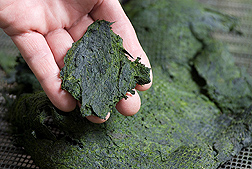This page has been archived and is being provided for reference purposes only. The page is no longer being updated, and therefore, links on the page may be invalid.
|
Read the magazine story to find out more. |
|
|
|
|
Algae Advances as a “Green” Alternative for Improving Water Quality
By Ann PerryMay 7, 2010
Algae—already being eyed for biofuel production—could be put to use right away to remove nitrogen and phosphorus in livestock manure runoff, according to an Agricultural Research Service (ARS) scientist. That could give resource managers a new eco-friendly option for reducing the level of agricultural pollutants that contaminate water quality in the Chesapeake Bay.
Microbiologist Walter Mulbry works at the ARS Environmental Management and Byproduct Utilization Research Unit in Beltsville, Md., which is located in the Chesapeake Bay watershed. In 2003, Mulbry set up four algal turf scrubber (ATS) raceways outside dairy barns in Beltsville. The shallow 100-foot raceways were covered with nylon netting that created a scaffold where the algae could grow.
For the next three years, from April until December, a submerged water pump at one end of the raceways circulated a mix of fresh water and raw or anaerobically digested dairy manure effluent over the algae. Within two to three weeks after the ATS system was started up every spring, the raceways supported thriving colonies of green filamentous algae.
Algae productivity was highest in the spring and declined during the summer, in part because of higher water temperatures and also because the raceways provided snails and midge larvae ample opportunity to graze on the algae.
Mulbry and his partners harvested wet algae every four to 12 days, dried it, and then analyzed the dried biomass for nitrogen and phosphorus levels. His results indicate that the ATS system recovered 60 to 90 percent of the nitrogen and 70 to 100 percent of the phosphorus from the manure effluents. They also calculated that the cost for this capture was comparable to other manure management practices—around $5 to $6 for each pound of nitrogen that was recovered and around $25 for each pound of phosphorus that was recovered.
Results from this research were published in Bioresource Technology.
Read more about this research in the May/June 2010 issue of Agricultural Research magazine.
ARS is the principal intramural scientific research agency of the U.S. Department of Agriculture.

